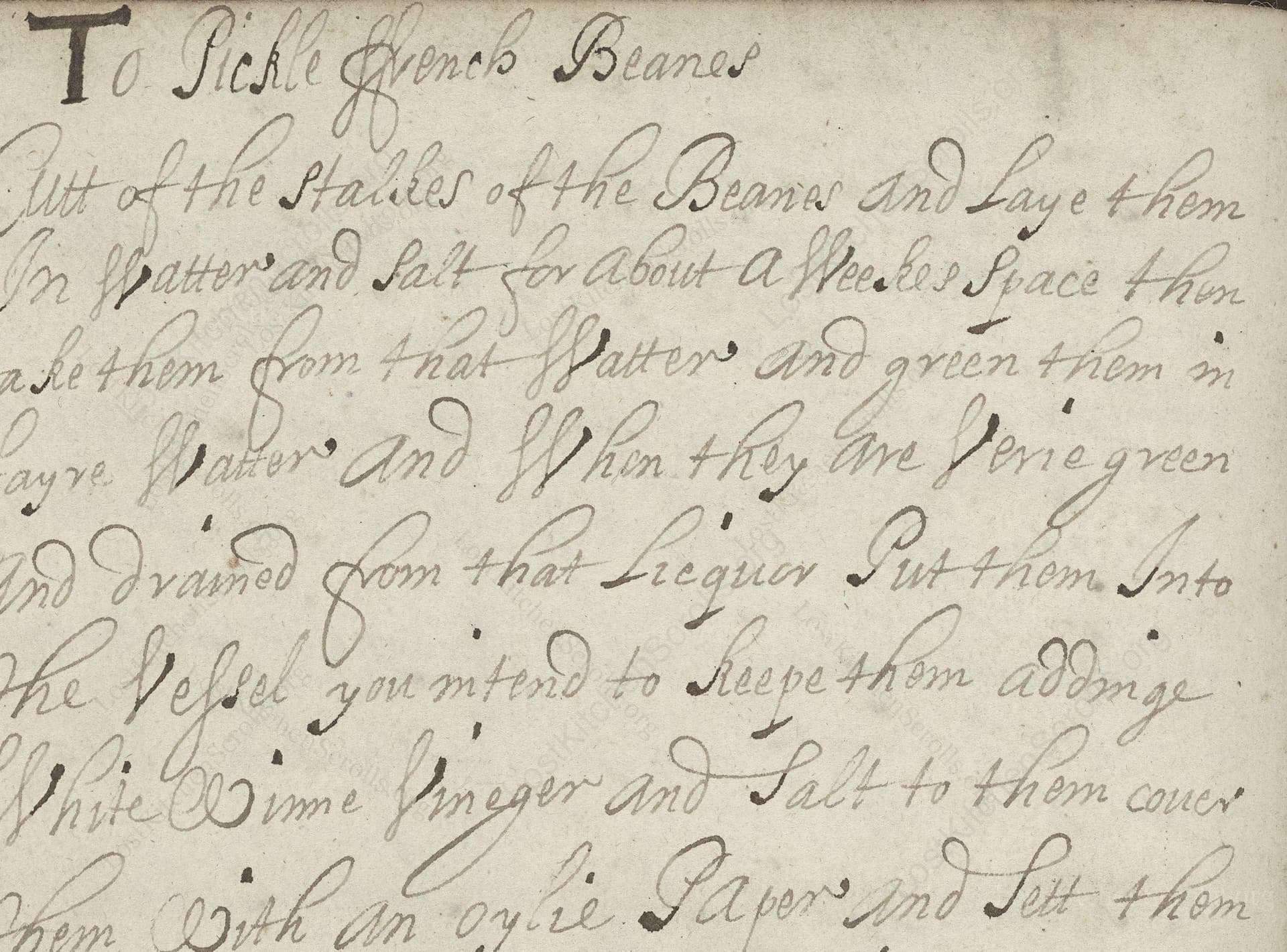To Pickle Green Beanes
From the treasured pages of Cookery and medicinal recipes of the Granville family from Worcestershire and Cadiz
Written by Granville family

To Pickle Green Beanes
"Cutt out of the Stalkes of the Beanes and Laye them In Watter and Salt for about a Weekes Space then take them from that Watter and green them in fayre Watter and When they Are Very green and Drained from that Licquor Put them Into the Vessel you intend to Keepe them Addinge White Winne Winegar and Salt to them Cover them With an Oylie Paper and Sett them by for your Vse in the Winter-----"
Note on the Original Text
The recipe is written in a continuous, instructive prose typical of early modern English household texts. The spelling reflects 17th-century norms: for example, 'watter' for 'water', 'winne winegar' for 'white wine vinegar', and 'lycquor' for 'liquor'. There is minimal punctuation and capitalization varies, making interpretation a playful puzzle. Recipes from this period assume some prior kitchen knowledge and rarely specify exact measurements or times, thus modern adaptations must fill in the gaps while honoring the spirit of the original.

Title
Cookery and medicinal recipes of the Granville family from Worcestershire and Cadiz (1695)
You can also click the book image above to peruse the original tome
Writer
Granville family
Era
1695
Publisher
Unknown
Background
A delightful journey through the culinary traditions of the Granville family, this historical recipe collection serves up a taste of English kitchens from the 17th and early 18th centuries. Brimming with time-honored techniques and flavors, it invites modern readers to savor the spirited inventiveness of early modern home cooks.
Kindly made available by
Folger Shakespeare Library
This recipe originates from the Granville family collection ('V.a.430'), dating between 1640 and 1750, a time when preserving seasonal food for winter was essential. Pickling vegetables like green beans allowed households to enjoy fresh flavors even in the lean months, reflecting both necessity and ingenuity in pre-industrial kitchens. The method of using salt and vinegar was typical for pickling before refrigeration, and the use of an 'oily paper' cover speaks to period methods of keeping air (and thus spoilage) away from preserved food.

Cooks of the 17th and 18th centuries would have used large earthenware or wooden bowls for brining, simple knives for trimming the beans, and pots over open fires for heating water. Beans were packed into stoneware jars or glazed earthenware vessels. 'Oylie paper' referred to parchment or paper brushed with oil to keep the pickles from direct exposure to air and possible spoilage.
Prep Time
20 mins
Cook Time
3 mins
Servings
5
We've done our best to adapt this historical recipe for modern kitchens, but some details may still need refinement. We warmly welcome feedback from fellow cooks and culinary historians — your insights support the entire community!
Ingredients
- 1 pound fresh green beans
- 3.5 ounces (about 1/3 cup) sea salt (for brining)
- 4 cups cold water (for brining)
- White wine vinegar (approx. 2 cups, or enough to cover)
- Olive oil (for oiling parchment, as substitute for oylie paper)
- Extra salt (about 0.5 tablespoon per jar for the vinegar stage)
- Parchment paper (to mimic oylie paper)
Instructions
- Trim the ends and stalks from 1 pound of fresh green beans.
- Place the beans in a large bowl and cover them with a brine made from around 4 cups of cold water and 3.5 ounces (about 1/3 cup) of salt.
- Let them soak in this brine for 7 days in the refrigerator, changing the brine once or twice if desired.
- After a week, drain the beans and blanch them quickly in boiling water for 2–3 minutes, until they turn a vivid green, then immediately drain and cool them under cold water.
- Pat them dry with a clean towel.
- Pack the beans into sterilized jars.
- Pour over enough white wine vinegar to cover the beans completely and add half a tablespoon of salt per 2 cups vinegar, making sure all are submerged.
- If you wish to mimic the original preservation, cut a circle of parchment paper, brush it lightly with olive oil, and place it on top of the beans in each jar.
- Seal the jars and store them in a cool, dark place for winter use.
Estimated Calories
35 per serving
Cooking Estimates
It takes around 20 minutes to prep the green beans and start the brine. Cooking (blanching) only takes a few minutes. Most of the time is waiting for the beans to soak for a week in the fridge. Each serving is about 100 grams, and each serving is low in calories since beans absorb little salt and vinegar.
As noted above, we have made our best effort to translate and adapt this historical recipe for modern kitchens, taking into account ingredients nowadays, cooking techniques, measurements, and so on. However, historical recipes often contain assumptions that require interpretation.
We'd love for anyone to help improve these adaptations. Community contributions are highly welcome. If you have suggestions, corrections, or cooking tips based on your experience with this recipe, please share them below.
Join the Discussion
Rate This Recipe
Dietary Preference
Main Ingredients

Den Bockfisch In Einer Fleisch Suppen Zu Kochen
This recipe hails from a German manuscript cookbook compiled in 1696, a time whe...

Die Grieß Nudlen Zumachen
This recipe comes from a rather mysterious manuscript cookbook, penned anonymous...

Ein Boudain
This recipe comes from an anonymous German-language manuscript cookbook from 169...

Ein Gesaltzen Citroni
This recipe, dating from 1696, comes from an extensive anonymous German cookbook...
Browse our complete collection of time-honored recipes



